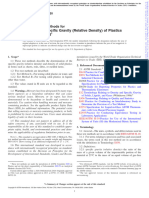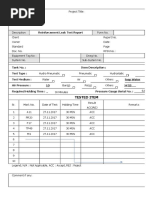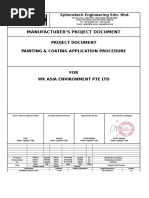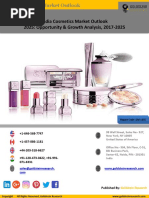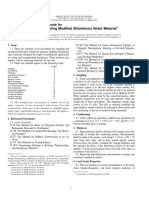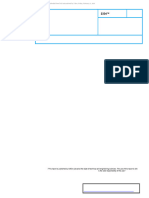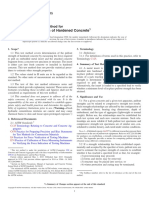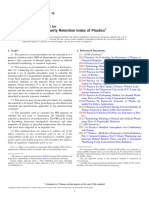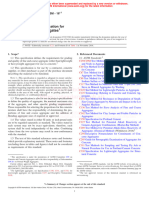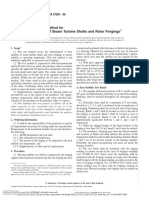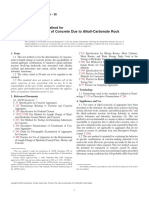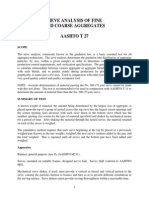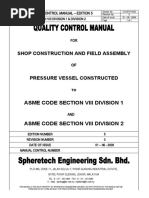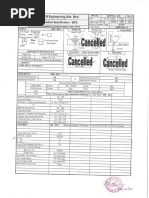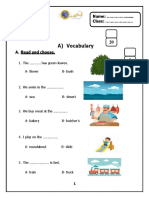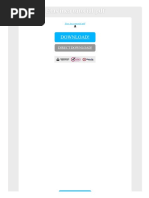Astm E84
Astm E84
Uploaded by
Mohd AshrafCopyright:
Available Formats
Astm E84
Astm E84
Uploaded by
Mohd AshrafOriginal Description:
Original Title
Copyright
Available Formats
Share this document
Did you find this document useful?
Is this content inappropriate?
Copyright:
Available Formats
Astm E84
Astm E84
Uploaded by
Mohd AshrafCopyright:
Available Formats
An American National Standard
Designation: E 84 – 03b
Standard Test Method for
Surface Burning Characteristics of Building Materials1
This standard is issued under the fixed designation E 84; the number immediately following the designation indicates the year of original
adoption or, in the case of revision, the year of last revision. A number in parentheses indicates the year of last reapproval. A superscript
epsilon (e) indicates an editorial change since the last revision or reapproval.
This standard has been approved for use by agencies of the Department of Defense.
1. Scope incorporate all factors required for fire-hazard or fire-risk
assessment of the materials, products, or assemblies under
--`,```,`,,`,,,,,,,`,,,```,``,-`-`,,`,,`,`,,`---
1.1 This fire-test-response standard for the comparative
surface burning behavior of building materials is applicable to actual fire conditions..
exposed surfaces such as walls and ceilings. The test is 1.8 This standard does not purport to address all of the
conducted with the specimen in the ceiling position with the safety concerns, if any, associated with its use. It is the
surface to be evaluated exposed face down to the ignition responsibility of the user of this standard to establish appro-
source. The material, product, or assembly shall be capable of priate safety and health practices and determine the applica-
being mounted in the test position during the test. Thus, the bility of regulatory limitations prior to use.
specimen shall either be self-supporting by its own structural 2. Referenced Documents
quality, held in place by added supports along the test surface,
or secured from the back side. 2.1 ASTM Standards:2
1.2 The purpose of this test method is to determine the A 390 Specification for Zinc-Coated (Galvanized) Steel
relative burning behavior of the material by observing the Poultry Fence Fabric (Hexagonal and Straight Line)3
flame spread along the specimen. Flame spread and smoke C 36 Specification for Gypsum Wallboard4
developed index are reported. However, there is not necessarily C 1186 Specification for Flat Non-Asbestos Fiber-Cement
a relationship between these two measurements. Sheets5
1.3 The use of supporting materials on the underside of the D 4442 Test Methods for Direct Moisture Content Measure-
test specimen has the ability to lower the flame spread index ment of Wood and Wood-Base Materials6
from those which might be obtained if the specimen could be D 4444 Test Methods for Use and Calibration of Hand-Held
tested without such support. These test results do not neces- Moisture Meters6
sarily relate to indices obtained by testing materials without E 69 Test Method for Combustible Properties of Treated
such support. Wood by the Fire-Tube Apparatus6
1.4 Testing of materials that melt, drip, or delaminate to E 136 Test Method for Behavior of Materials in a Vertical
such a degree that the continuity of the flame front is destroyed, Tube Furnace at 750°C7
results in low flame spread indices that do not relate directly to E 160 Test Method for Combustible Properties of Treated
indices obtained by testing materials that remain in place. Wood by the Crib Test8
1.5 The values stated in inch-pound units are to be regarded E 162 Test Method for Surface Flammability of Materials
as the standard. Using a Radiant Heat Energy Source7
1.6 The text of this standard references notes and footnotes E 176 Terminology of Fire Standards7
that provide explanatory information. These notes and foot- E 286 Test Method for Surface Flammability of Building
notes, excluding those in tables and figures, shall not be
considered as requirements of the standard.
2
1.7 This standard is used to measure and describe the For referenced ASTM standards, visit the ASTM website, www.astm.org, or
contact ASTM Customer Service at service@astm.org. For Annual Book of ASTM
response of materials, products, or assemblies to heat and Standards volume information, refer to the standard’s Document Summary page on
flame under controlled conditions, but does not by itself the ASTM website.
3
Annual Book of ASTM Standards, Vol 01.06.
4
Annual Book of ASTM Standards, Vol 04.01.
5
1
This test method is under the jurisdiction of ASTM Committee E5 on Fire Annual Book of ASTM Standards, Vol 04.05.
6
Standards and is the direct responsibility of Subcommittee E05.22 on Surface Annual Book of ASTM Standards, Vol 04.10.
7
Burning. Annual Book of ASTM Standards, Vol 04.07.
8
Current edition approved August 10, 2003. Published October 2003. Originally Discontinued; see 1993 Annual Book of ASTM Standards, Vol 04.09.
approved in 1950. Last previous edition approved in 2003 as E 84 – 03a.
Copyright © ASTM International, 100 Barr Harbor Drive, PO Box C700, West Conshohocken, PA 19428-2959, United States.
Copyright ASTM International 1 Document provided by IHS Licensee=ExxonMobil/1890500101, 03/16/2004 03:29:53
Reproduced by IHS under license with ASTM MST Questions or comments about this message: please call the Document Policy
Group at 303-397-2295.
E 84 – 03b
Materials Using an 8-ft (2.44-m) Tunnel Furnace9 4.2 This test method exposes a nominal 24-ft (7.32-m) long
by 20-in. (508-mm) wide specimen to a controlled air flow and
3. Terminology flaming fire exposure adjusted to spread the flame along the
3.1 Definitions—For definitions of terms used in this test entire length of the select grade red oak specimen in 51⁄2 min.
method refer to Terminology E 176. The term flame spread 4.3 This test method does not provide for the following:
index from Terminology E 176 is of particular interest to this 4.3.1 Measurement of heat transmission through the tested
standard and is defined in 3.1.1. surface.
3.1.1 flame spread index, n—a number or classification 4.3.2 The effect of aggravated flame spread behavior of an
indicating a comparative measure derived from observations assembly resulting from the proximity of combustible walls
made during the progress of the boundary of a zone of flame and ceilings.
under defined test conditions. 4.3.3 Classifying or defining a material as noncombustible,
3.2 Definitions of Terms Specific to This Standard: by means of a flame spread index by itself.
3.2.1 smoke developed index, n—a number or classification
indicating a comparative measure derived from smoke obscu- 5. Apparatus
ration data collected during the test for surface burning 5.1 Fire Test Chamber—See Figs. 1-5.
characteristics. 5.1.1 The fire test chamber is a rectangular horizontal duct
3.2.2 surface flame spread, n—the propagation of a flame with a removable lid. The inside dimensions are as follows:
away from the source of ignition across the surface of the
Width: 17 3⁄4 6 1⁄4 in. (451 6 6.3 mm) measured between the top
specimen. ledges along the side walls, and 17 5⁄8 6 3⁄8 in. (448 6 10
mm) at all other points.
4. Significance and Use Depth: 12 6 1⁄2 in. (305 6 13 mm) measured from the bottom of
the test chamber to the top of the ledges on which the
4.1 This test method is intended to provide only compara- specimen is supported. This measurement includes the 1⁄8
tive measurements of surface flame spread and smoke density in. (3.2 mm) thickness of the 1 1⁄2 in. (38 mm) wide woven
fiberglass gasket tape.
measurements with that of select grade red oak and reinforced Length: 25 ft 6 3 in. (7.62 m 6 76 mm).
cement board surfaces under the specific fire exposure condi-
tions described herein. 5.1.2 The sides and base of the chamber shall be lined with
an insulating firebrick with the dimensions of 4 1⁄2 in. by 9 in.
by 2 1⁄2 in. thick as illustrated in Fig. 2. The insulating firebrick
9
Discontinued; see 1991 Annual Book of ASTM Standards, Vol 04.07. shall have the following properties:
--`,```,`,,`,,,,,,,`,,,```,``,-`-`,,`,,`,`,,`---
FIG. 1 Test Furnace, Showing Some Critical Dimensions (Not a Construction Drawing)
Copyright ASTM International 2 Document provided by IHS Licensee=ExxonMobil/1890500101, 03/16/2004 03:29:53
Reproduced by IHS under license with ASTM MST Questions or comments about this message: please call the Document Policy
Group at 303-397-2295.
--`,```,`,,`,,,,,,,`,,,```,``,-`-`,,`,,`,`,,`--- E 84 – 03b
FIG. 2 Test Furnace Showing Critical Dimensions (Not a Construction Drawing)
Maximum Recommended Temperature 2600°F (1424°C) so that the entire length of the test sample is observable from
Bulk Density 50 6 3 lb/ft3 (0.77 6 0.046 g/cm3) outside the fire chamber. The windows shall be pressure tight
Thermal Conductivity at Mean
Temperature of
Btu•in./hr•ft2•°F W/m•°C in accordance with 7.2 and 7.2.1.
400°F (205°C) 1.7 0.24 5.1.4 The ledges shall be fabricated of structural materials11
800°F (425°C) 1.9 0.27 capable of withstanding the abuse of continuous testing. The
1200°F (650°C) 2.2 0.32
1600°F (870°C) 2.6 0.37 ledges shall be level with respect to the length and width of the
2000°F (1095°C) 3.2 0.46 chamber and each other. The ledges shall be maintained in a
2400°F (1315°C) 3.9 0.56 state of repair commensurate with the frequency, volume, and
5.1.3 One side of the chamber shall be provided with double severity of testing occurring at any time.
observation windows10 with the inside pane flush mounted (see 5.1.5 Lid:
Fig. 2). Exposed inside glass shall be 2 3⁄4 6 3⁄8 by 11 + 1, −2 5.1.5.1 The lid shall consist of a removable noncombustible
in. (70 6 10 by 279 + 25 − 50 mm). The centerline of the metal and mineral composite structure as shown in Fig. 2 and
exposed area of the inside glass shall be in the upper half of the of a size necessary to cover completely the fire test chamber
furnace wall, with the upper edge not less than 2.5 in. (63 mm) and the test samples. The lid shall be maintained in an
below the furnace ledge. The window shall be located such that unwarped and flat condition. When in place, the lid shall be
not less than 12 in. (305 mm) of the specimen width can be completely sealed to prevent air leakage into the fire test
observed. Multiple windows shall be located along the tunnel chamber during the test.
10
Heat-resistant glass, high-silica, 100 % silica glass, nominal 1⁄4-in. thick has
11
been found suitable for the interior pane. Borosilicate glass, nominal 1⁄4-in. thick has High-temperature furnace refractory. Zirconium silicate, or water-cooled steel
been found suitable for the exterior pane. tubing have been found suitable for this purpose.
Copyright ASTM International 3 Document provided by IHS Licensee=ExxonMobil/1890500101, 03/16/2004 03:29:53
Reproduced by IHS under license with ASTM MST Questions or comments about this message: please call the Document Policy
Group at 303-397-2295.
E 84 – 03b
--`,```,`,,`,,,,,,,`,,,```,``,-`-`,,`,,`,`,,`---
FIG. 3 Typical Exhaust End Transition (Not a Construction Drawing)
5.1.5.2 The lid shall be insulated with a minimal thickness to the burners shall be provided through a single inlet pipe,
of 2 in. (51 mm) castable insulation or mineral composite distributed to each port burner through a tee-section. The outlet
material having physical characteristics comparable to the shall be a 3⁄4 in. NPT elbow. The plane of the port shall be
following: parallel to the furnace floor, such that the gas is directed
Maximum effective use temperature of upward toward the specimen. Each port shall be positioned
at least: 1200°F (650°C) with its centerline 4 6 1⁄2 in. (102 6 13 mm) on each side of
Bulk density 21 lb/ft3 (336 kg/m3)
Thermal conductivity at 300 to 700°F 0.50 to 0.71 Btu·in./h·ft2·°F (0.072 to
the centerline of the furnace so that the flame is distributed
(149 to 371°C) 0.102 W/m·K) evenly over the width of the exposed specimen surface (see
5.1.5.3 The entire lid assembly shall be protected with flat Fig. 2).
sections of nominal 1⁄4-in. (6.3-mm) reinforced cement board 5.1.6.2 The controls used to assure constant flow of gas to
meeting the properties of Annex A3. This protective board the burners during period of use shall consist of a pressure
shall be maintained in sound condition through continued regulator, a gas meter calibrated to read in increments of not
replacement. The protective board is to be secured to the more than 0.1 ft3 (2.8 L), a manometer to indicate gas pressure
furnace lid or place on the back side of the test specimen. in inches of water, a quick-acting gas shut-off valve, and a gas
5.1.6 Gas Burners: metering valve.
5.1.6.1 One end of the test chamber shall be designated as 5.1.7 Air Intake:
the “fire end”. This fire end shall be provided with two gas 5.1.7.1 An air intake shutter shall be located 54 6 5 in.
burners delivering flames upward against the surface of the test (1372 6 127 mm) upstream of the burner, as measured from
sample (see Fig. 2). The burners shall be spaced 12 in. (305 the burner centerline to the outside surface of the shutter (see
mm) from the fire end of the test chamber, and 7 1⁄2 6 1⁄2 in. Fig. 1). The air intake is to be fitted with a vertically sliding
(190 6 13 mm) below the under surface of the test sample. Gas shutter extending the entire width of the test chamber. The
Copyright ASTM International 4 Document provided by IHS Licensee=ExxonMobil/1890500101, 03/16/2004 03:29:53
Reproduced by IHS under license with ASTM MST Questions or comments about this message: please call the Document Policy
Group at 303-397-2295.
E 84 – 03b
5.1.7.2 To provide air turbulance for proper combustion,
turbulance baffling shall be provided by positioning six refrac-
tory firebricks (as defined in 5.1.2) along the side walls of the
chamber. With the long dimension vertical, 4 1⁄2 in. (114-mm)
dimension along the wall, place the bricks as follows from the
centerline of the burner ports:
On the window side at 7, 12, and 20 6 1⁄2 ft (2.1, 3.7, and 6.1 6 0.2 m)
On the opposite side at 4 1⁄2 , 9 1⁄2 , and 16 6 1⁄2 ft (1.3, 2.9, and 4.9 6 0.2 m)
5.1.7.3 The movement of air shall be by an induced draft
system having a total draft capacity of at least 0.15 in. (3.8
mm) water column with the sample in place, the shutter at the
fire end open the normal 3 6 1⁄16 in. (76 6 2 mm), and the
damper in the wide open position. A draft gage tap to indicate
static pressure shall be inserted through the top at the midwidth
of the tunnel, 1 6 0.5 in. (25 6 12 mm) below the ceiling, 15
6 0.5 in. (381 6 12 mm) downstream from the inlet shutter
(see Fig. 1).
5.1.8 Exhaust End:
5.1.8.1 The other end of the test chamber is designated as
the exhaust end. The exhaust end shall be fitted with a gradual
rectangular-to-round transition piece, not less than 20 in. (508
mm) in length, with a cross-sectional area of not less than 200
in.2 (1290 cm2) at any point (see Fig. 3).
5.1.8.2 The transition piece shall in turn be fitted to a 16 in.
(406 mm) diameter duct pipe. A typical duct system shown in
Fig. 4 contains two 90° elbows (see Fig. 5) with the exhaust
duct running beside the fire test chamber. In order to comply
with this typical design, the vertical centerline of the exhaust
duct system is identical to that of the fire test chamber.
5.1.8.3 The exhaust duct is to be insulated with at least 2 in.
(51 mm) of high temperature mineral composition material
from the exhaust end of the fire chamber to the photometer
location.
5.1.8.4 An exhaust fan shall be installed at the end of the
exhaust duct. The air flow shall be controlled as specified in
5.1.11.
5.1.8.5 An alternative exhaust duct layout design shall
demonstrate equivalency by meeting the requirements speci-
fied in Section 7.
5.1.9 Photometer System:
5.1.9.1 A photometer system consisting of a lamp12 and
photocell13 shall be mounted on a horizontal section of the
16-in. (406-mm) diameter vent pipe at a point where it will be
preceded by a straight run of pipe (at least 12 diameters or 16
ft (4.88 m) and not more than 30 diameters or 40 ft (12.19 m)
from the vent end of the chamber, and with the light beam
directed upward along the vertical axis of the vent pipe. The
vent pipe shall be insulated with at least 2 in. (51 mm) of
12
The sole source of supply of the apparatus known to the committee at this time
is 12-V sealed beam, clear lens, auto spot lamp, No. 4405, from General Electric,
FIG. 4 Plan View—Typical Duct System (Not a Construction
Nela Park, OH. If you are aware of alternative suppliers, please provide this
Drawing) information to ASTM Headquarters. Your comments will receive careful consider-
ation at a meeting of the responsible technical committee,1 which you may attend.
13
The sole source of supply of the apparatus known to the committee at this time
is No. 856BB from Weston Instruments, Wauconda, IL. If you are aware of
shutter shall be positioned so as to provide an air inlet port 3 6 alternative suppliers, please provide this information to ASTM Headquarters. Your
1⁄16 in. (76 6 2 mm) high measured from the floor level of the
comments will receive careful consideration at a meeting of the responsible
test chamber at the air intake point. technical committee,1 which you may attend.
--`,```,`,,`,,,,,,,`,,,```,``,-`-`,,`,,`,`,,`---
Copyright ASTM International 5 Document provided by IHS Licensee=ExxonMobil/1890500101, 03/16/2004 03:29:53
Reproduced by IHS under license with ASTM MST Questions or comments about this message: please call the Document Policy
Group at 303-397-2295.
--`,```,`,,`,,,,,,,`,,,```,``,-`-`,,`,,`,`,,`---
E 84 – 03b
FIG. 5 Typical Duct Elbow (Not a Construction Drawing)
high-temperature mineral composition material, from the vent gasketing tape and 23 ft 6 1⁄2 in. (7.0 m 6 13 mm) from the
end of the chamber to the photometer location. The photoelec- centerline of the burner ports at the center of its width.
tric cell of which the output is directly proportional to the 5.1.11.2 Two No. 18 Awg (1.02 mm) thermocouples are
amount of light received shall be mounted over the light source embedded below the floor surface of the test chamber. These
and connected to a recording device having a minimum thermocouples shall be mounted at distances of 13 ft 6 1⁄2 in.
operating chart width of 5 in. (127 mm) with an accuracy (3.96 m 6 13 mm) and 23 1⁄4 ft 6 1⁄2 in. (7.09 m 6 13 mm)
within 61 % of full scale, for indicating changes in the measured from the centerline of the burner ports. The thermo-
attenuation of incident light by the passing smoke, particulate, couples shall be inserted from below the fire test chamber
and other effluent. The distance between the light source lens through the firebrick until the tip of the thermocouple is 1⁄8 6
and the photocell lens shall be 36 6 4 in. (914 6 102 mm). The 1⁄32 in. (3.2 6 0.8 mm) below the floor surface. The tip of the
cylindrical light beam shall pass through 3-in. (76-mm) diam- thermocouples shall be covered with refractory or portland
eter openings at the top and bottom of the 16-in. diameter duct, cement, carefully dried to avoid cracking.
with the resultant light beam centered on the photocell.
5.1.9.2 Linearity of the photometer system shall be verified 6. Test Specimens
periodically by interrupting the light beam with calibrated
6.1 Specimens shall be representative of the materials which
neutral density filters. The filters shall cover the full range of
the test is intended to examine. The report shall include
the recording instrument. Transmittance values measured by
information on the composition needed for identification of the
the photometer, using neutral density filters, shall be within
test specimen as described in 11.1.1.
63 % of the calibrated value for each filter.
5.1.10 Draft Regulating Device: 6.2 The specimen shall be provided in one of two ways: (1)
5.1.10.1 An automatically controlled damper to regulate the a continuous, unbroken length; (2) sections that will be joined
draft pressure shall be installed in the vent pipe down-stream of or butted end-to-end.
the smoke-indicating attachment. The damper shall be pro- 6.3 The size of the test specimen shall be:
vided with a manual override. Width: between 20 and 24 in. (508 and 610 mm)
5.1.10.2 Other manual or automatic draft regulation de- Length: 24 ft + 12 in. — 6 in.
vices, or both, are allowed to be incorporated to help maintain Thickness: maximum 4 in. (101 mm).
fan characterization and air-flow control throughout the test.
5.1.11 Thermocouples: NOTE 1—The test apparatus is not designed for testing at thicknesses
greater than 4 in. (101 mm), but has the ability to be modified if required.
5.1.11.1 A No. 18 Awg (1.02-mm) thermocouple, with 3⁄8 6 This is accomplished through (a) modifications to the test apparatus lid to
1⁄8 in. (9.5 6 3.2 mm) of the junction exposed in the air, shall
maintain an airtight seal, and (b) the introduction, usually of additional
be inserted through the floor of the test chamber so that the tip sample/lid supports above the test apparatus ledges. Due to the composi-
is 1 6 1⁄32 in. (25.4 6 0.8 mm) below the top surface of the tion of some materials, test results obtained at a thickness greater than 4
Copyright ASTM International 6 Document provided by IHS Licensee=ExxonMobil/1890500101, 03/16/2004 03:29:53
Reproduced by IHS under license with ASTM MST Questions or comments about this message: please call the Document Policy
Group at 303-397-2295.
E 84 – 03b
in. (101 mm) will potentially vary from results of a test on the same 7.3.1 The following alternative to the velocity transducer
material tested at a thickness of 4 in. (101 mm) or less. equipment and method of determining the tunnel air velocity
6.4 The test specimen shall be conditioned to a constant has been found suitable: A 4–in.diameter low-speed rotary
weight at a temperature of 73.4 6 5°F (23 6 2.8°C) and at a vane anemometer, having a resolution of 1 ft./min. with an
relative humidity of 50 6 5%. accuracy of 6 2 %, is attached to the steel stand and placed in
6.5 The upstream end of the fire test chamber shall be filled the tunnel 22.5 ft downstream of the burners. Three trials shall
with a 14 6 1⁄8 —in. (356 6 3 mm) length of uncoated be conducted and their values averaged. The average is
16–guage (0.053 to 0.060 in.) steel plate positioned on the rounded to the nearest unit. The centerline of the vane
specimen mounting ledge in front of and under the leading anemometer shall be aligned with the vertical centerline of the
edge of the specimen. tunnel by placing it on the steel stand. Trial 1 is run with the
6.6 When the overall length of the test specimen exceeds 24 vane edge 1 in. from the non-window wall; Trial 2 is with the
ft. (7.32 m), butt one end of the test specimen against the center axis at the tunnel center point; and Trial 3 is run with the
exhaust end of the fire test chamber and continue the installa- vane edge 1 in. from the window wall.
tion of the specimen toward the gas burner. 7.4 The room in which the test chamber is located shall have
6.7 When the overall length of the test specimen is 24 ft. provision for a free inflow of air during test to maintain the
(7.32 m) or less, provide a 1 in. (25 mm) overlap of the steel room at atmospheric pressure during the entire test run.
plate at the upstream end with one end of the test specimen and Maintain the air supply at a temperature of 73.4 6 5°F (23 6
continue the installation of the specimen toward the exhaust 2.8°C) and a relative humidity of 50 6 5 %.
end. 7.5 Supply the fire test chamber with natural (city) or
7. Calibration methane (bottled) gas fuel of uniform quality with a heating
value of nominally 1000 Btu/ft3 (37.3 MJ/m3). Adjust the gas
7.1 Place a nominal 1⁄4-in. (6.3-mm) reinforced cement
supply initially at approximately 5000 Btu (5.3 MJ)/min.
board meeting the properties of Annex A3 on the ledge of the
Record the gas pressure, the pressure differential across the
furnace chamber. Place the removable lid of the test chamber in
orifice plate, and the volume of gas used in each test. If a
position.
temperature- and pressure-compensating mass flowmeter is
7.2 With the 1⁄4-in. (6.3-mm) reinforced cement board in
utilized, record only the volume of gas used. Unless otherwise
position on top of the ledge of the furnace chamber and with
corrected for, when bottled methane is employed, insert a
the removable lid in place, establish a draft to produce a
length of coiled copper tubing into the gas line between the
0.15-in. (3.8-mm) water-column reading on the draft manom-
supply and metering connection to compensate for possible
eter, with the fire-end shutter open 3 6 1⁄16 in. (76 6 1.5 mm),
errors in the flow indicated due to reductions in gas tempera-
by manually setting the damper as a characterization of fan
ture associated with the pressure drop and expansion across the
performance. Then close and seal the fire-end shutter, without
regulator. With the draft and gas supply adjusted as indicated in
changing the damper position. The manometer reading shall
7.3 and 7.4, the test flame shall extend downstream to a
increase to at least 0.375 in. (9.53 mm), indicating that no
distance of 41⁄2 ft (1.37 m) over the specimen surface, with
excessive air leakage exists.
negligible upstream coverage.
7.2.1 In addition, conduct a supplemental leakage test peri-
odically with the tunnel sealed from the inlet end to beyond the 7.6 Preheat the test chamber with the 1⁄4-in. (6.3-mm)
photometer system, by placing a smoke bomb in the chamber. reinforced cement board and the removable lid in place and
Ignite the bomb and pressurize the chamber to 0.375 6 0.125 with the fuel supply adjusted to the required flow. Continue the
in. (9.53 6 3.18 mm) water column. Seal all points of leakage preheating until the temperature indicated by the floor thermo-
observed in the form of escaping smoke particles. couple at 231⁄4 ft (7.09 m) reaches 150 6 5°F (66 6 2.8°C).
7.3 Establish a draft reading within the range 0.055 to 0.100 During the preheat test, record the temperatures indicated by
in. (1.40 to 2.54 mm) water column. The required draft gage the thermocouple at the vent end of the test chamber at
reading will be maintained throughout the test by the automati- intervals not longer than 15 s and compare these readings to the
cally controlled damper. Record the air velocity at seven preheat temperature shown in the time-temperature curve in
points, 23 ft from the centerline of the burner ports, 6 6 1⁄4 in. Fig. 3. This preheating is for the purpose of establishing the
(168 6 7 mm) below the plane of the specimen mounting conditions that will exist following successive tests and for
ledge. Determine these seven points by dividing the width of indicating the control of the heat input into the test chamber. If
the tunnel into seven equal sections and recording the velocity appreciable variation from the temperatures shown in the
--`,```,`,,`,,,,,,,`,,,```,``,-`-`,,`,,`,`,,`---
at the geometrical center of each section. During the measure- representative preheat curve is observed, suitable adjustments
ment of velocity, remove the turbulence bricks (see 4.3) and the in the fuel supply may be necessary based on red oak
exposed 23-ft thermocouple and place 24-in. (670-mm) long calibration tests.
straightening vanes between 16 and 18 ft (4.88 and 5.49 m) 7.7 Allow the furnace to cool after each test. When the floor
from the burner. The straightening vanes shall divide the thermocouple at 13 ft (3.96 m) shows a temperature of 105 6
furnace cross section into nine uniform sections. Determine the 5°F (40.5 6 2.8°C), place the next specimen in position for
velocity with furnace air temperature at 73.4 6 5°F (23 6 test.
2.8°C), using a velocity transducer. The velocity, determined as 7.8 With the test equipment adjusted and conditioned as
the arithmetic average of the seven readings, shall be 240 6 5 described in 7.2, 7.3, 7.4, and 7.6, make a test or series of tests,
ft (73.2 6 1.4 m)/min. using nominal 23⁄32-in. (18.3-mm) select-grade red oak flooring
Copyright ASTM International 7 Document provided by IHS Licensee=ExxonMobil/1890500101, 03/16/2004 03:29:53
Reproduced by IHS under license with ASTM MST Questions or comments about this message: please call the Document Policy
Group at 303-397-2295.
E 84 – 03b
as a sample. The red oak decks are to be constructed and temperature- and pressure-compensating mass flowmeter de-
conditioned as specified in Annex A1 and Annex A2. Make vice is used to monitor the gas flow, record only the volume of
observations at distance intervals not in excess of 2 ft (0.6 m) gas.
and time intervals not in excess of 30 s, and record the time 8.6 When the test is ended, shut off the gas supply, observe
when the flame reaches the end of the specimen 191⁄2 ft (5.94 smoldering and other conditions within the test duct, and
m) from the end of the ignition fire. The end of the ignition fire remove the specimen for further examination.
shall be considered as being 41⁄2 ft (1.37 m) from the burners. 8.7 Plot the flame spread distance, temperature, and change
The flame shall reach the end point in 51⁄2 min6 15 s. in photoelectric cell readings separately on the same type of
Automatically record the temperatures measured by the ther- coordinate paper as used in 7.9 for use in determining the
mocouple near the vent end at least every 15 s. Automatically flame-spread and smoke-developed indexes as outlined in
record the photoelectric cell output immediately prior to the Section 9. Flame front advancement shall be recorded at the
test and at least every 15 s during the test. time of occurrence or at least every 30 s if no advancement is
7.8.1 Another means of judging when the flame has reached noted. Flame spread distance shall be determined as the
the end point is when the exposed thermocouple at 23 ft observed distance minus 41⁄2 ft (1.37 m).
registers a temperature of 980°F (527°C).
7.9 Plot the flame spread distance, temperature, and change 9. Interpretation of Results
in photoelectric cell readings separately on suitable coordinate
9.1 The flame spread index (FSI) shall be the valve,
paper. Figs. 4-6 are representative curves for red oak flame
determined as follows, rounded to the nearest multiple of five.
spread distance, time-temperature development, and smoke
9.1.1 In plotting the flame spread distance-time relationship,
density, respectively. Flame spread distance shall be deter-
all progressive flaming as previously recorded shall be in-
mined as the observed distance minus 41⁄2 ft (1.37 m).
cluded at the time of occurrence. A straight line shall be used
7.10 Following the calibration tests for red oak, conduct a
to connect successive points. The total area (AT) under the
similar test or tests on samples of 1⁄4-in. (6.3-mm) reinforced
flame spread distance-time plot shall be determined by ignor-
cement board. These results shall be considered as representing
ing any flame front recession. For example, in Fig. 8 the flame
an index of 0. Plot the temperature readings separately on
spreads 10 ft (3.05 m) in 21⁄2 min and then recedes. The area is
suitable coordinate paper. Fig. 7 is a representative curve for
calculated as if the flame had spread to 10 ft in 21⁄2 min and
time-temperature development for reinforced cement board.
then remained at 10 ft for the remainder of the test or until the
8. Procedure flame front again passed 10 ft. This is shown by the dashed line
8.1 With the furnace draft operating, place the test specimen in Fig. 8. The area (AT) used for calculating the flame spread
on the test chamber ledges that have been completely covered index is the sum of areas A1 and A2 in Fig. 8.
with nominal 1⁄8-in. (3.2-mm) thick by 11⁄2-in. (38-mm) wide 9.1.2 If this total area (AT) is less than or equal to 97.5
woven gasketing tape. Place the specimen as quickly as is ft·min, the flame spread index shall be 0.515 times the total
practical. Place the removable top in position over the speci- area (FSI = 0.515 AT).
men. 9.1.3 If the total area (AT) is greater than 97.5 ft·min, the
8.2 Keep the completely mounted specimen in position in flame spread index shall be 4900, divided by the difference of
the chamber with the furnace draft operating for 120 6 15 s 195 minus the total area (AT). (FSI = 4900/(195 − AT)).
prior to the application of the test flame. 9.2 The test results for smoke shall be plotted, using the
8.3 Ignite the burner gas. Observe and record the distance same coordinates as in 7.9. The area under the curve shall be
and time of maximum flame front travel with the room divided by the area under the curve for red oak, multiplied by
darkened. Continue the test for a 10-min period. Termination of 100, and rounded to the nearest multiple of five to establish a
the test prior to 10 min is permitted if the specimen is numerical smoke-developed index. The performance of the
completely consumed in the fire area and no further progres- material is compared with that of reinforced cement board and
sive burning is evident and the photoelectric cell reading has select grade red oak flooring, which have been arbitrarily
returned to the baseline. established as 0 and 100, respectively. For smoke-developed
8.4 Record the photoelectric cell output immediately prior indexes 200 or more, the calculated value shall be rounded to
to the test and at least every 15 s during the test. the nearest 50 points.
8.5 Record the gas pressure, the pressure differential across NOTE 2—Allowance should be made for accumulation of soot and dust
the orifice plate, and the volume of gas used in each test. If a on the photoelectric cell during the test by establishing a revised base line.
The revised base line shall be a straight line drawn from the zero point
(point on base line where incipient light attenuation occurs) to the point
established after the sample has been removed.
10. Analysis of Products of Combustion
10.1 Samples for combustion product analysis, when analy-
sis is requested, shall be taken downstream from the photom-
eter, or shall consist of not more than 1 % of the total flow.
FIG. 6 Representative Time-Absorption Curve for Smoke Density Analysis of the products of combustion is not required in this
of Red Oak test method.
--`,```,`,,`,,,,,,,`,,,```,``,-`-`,,`,,`,`,,`---
Copyright ASTM International 8 Document provided by IHS Licensee=ExxonMobil/1890500101, 03/16/2004 03:29:53
Reproduced by IHS under license with ASTM MST Questions or comments about this message: please call the Document Policy
Group at 303-397-2295.
E 84 – 03b
--`,```,`,,`,,,,,,,`,,,```,``,-`-`,,`,,`,`,,`---
FIG. 7 Representative Time-Temperature Curve for Fuel Contribution of Reinforced Cement Board
FIG. 8 Example of Time-Distance Relationship with Flame Front Recession
(Total Area, AT = A1 + A2)
11. Report 11.1.5 Graphical plots of flame spread and smoke developed
11.1 Report the following information: data.
11.1.1 Description of the material being tested, including its 12. Precision and Bias 14
composition or generic identification, thickness, and any rel-
evant additional details, 12.1 Precision—A series of interlaboratory tests for this test
11.1.2 Test results as calculated in Section 9, method was run using eleven laboratories and six materials.
11.1.3 Details of the method used in placing the specimen in Four replicates of each material were tested. The complete
the chamber, to include the following: results have been placed on file at ASTM Headquarters as a
11.1.3.1 A statement whether a continuous or sectioned Research Project entitled “Interlaboratory Test Study on ASTM
specimen is used, E84, Standard Test Method for Surface Burning Characteristics
11.1.3.2 A description of the number of sections and their of Building Materials.” Data was calculated in accordance with
sizes, when the specimen consists of sections joined end-to- Practice E 691 and ISO 5725.
end, 12.2 Even though Test Method E 84 provides measurement
11.1.3.3 The mounting method employed, of a Flame Spread Index and a Smoke Developed Index, only
11.1.3.4 The method of placement of the cement board the Flame Spread Index is considered in this precision state-
protecting the furnace lid assembly. ment because the test series utilized a smoke measurement
11.1.4 Observations of the burning characteristics of the
specimen during test exposure, such as delamination, sagging, 14
Supporting data have been filed at ASTM Headquarters and may be obtained
shrinkage, fallout, etc., and by requesting PCN 33000014-31.
Copyright ASTM International 9 Document provided by IHS Licensee=ExxonMobil/1890500101, 03/16/2004 03:29:53
Reproduced by IHS under license with ASTM MST Questions or comments about this message: please call the Document Policy
Group at 303-397-2295.
E 84 – 03b
system that was a variation from that described in the test TABLE 2 Between-Laboratory (Reproducibility) Precision Data
method. Data on precision of the smoke developed index is Parameter—Flame Spread Index
being worked on by Task Group No. 1 of Subcommittee E5.22 Material Reproducibility Relative
and will be included in a future revision of this test method. Standard Standard
Mean Value Deviation, SR Deviation,%
12.3 Within-laboratory (repeatability) data is given in Table
1. Douglas Fir Plywood 91 23 25
Fire Retardant Treated 17 6 33
12.4 Between-laboratory (reproducibility) data is given in Douglas Fir Plywood
Table 2. Type X Gypsum Board 9 3 36
12.5 Bias—No information is presented on the bias of the Rigid Polystyrene Foam 7 4 60
Rigid Polyurethane Foam 24 5 23
procedure in this test method because correct values for Composite Panel 17 4 21
TABLE 1 Within-Laboratory (Repeatability) Precision Data
Parameter—Flame Spread Index
Repeatability Relative fire-test-response characteristics of building materials can only
Material
Standard Standard be defined in terms of a test method. Within this limitation, this
Mean Value Deviation, Sr Deviation,% test method has no known bias and can be accepted as a
Douglas Fir Plywood 91 15 16 reference method.
Fire Retardant Treated 17 3 17
Douglas Fir Plywood
Type X Gypsum Board 9 2 19 13. Keywords
Rigid Polystyrene Foam 7 1 18 13.1 flame spread; flame spread index; smoke developed;
Rigid Polyurethane Foam 24 3 13
Composite Panel 17 2 12 smoke developed index; Steiner tunnel; surface burning char-
acteristics; 25 ft tunnel; tunnel test
ANNEXES
(Mandatory Information)
A1. CONSTRUCTION GUIDELINES OF RED OAK DECKS
A1.1 Introduction
A1.1.1 General construction outline of the red oak decks is
shown in Fig. A1.1.
--`,```,`,,`,,,,,,,`,,,```,``,-`-`,,`,,`,`,,`---
Copyright ASTM International 10 Document provided by IHS Licensee=ExxonMobil/1890500101, 03/16/2004 03:29:53
Reproduced by IHS under license with ASTM MST Questions or comments about this message: please call the Document Policy
Group at 303-397-2295.
E 84 – 03b
FIG. A1.1 Red Oak Calibration Deck Construction
A2. PROCEDURE FOR DETERMINING MOISTURE CONTENT IN RED OAK
A2.1 Introduction tioning atmosphere that will result in an average moisture
A2.1.1 This procedure shall be used for the determination of content of 7 6 0.5 %. Using either a conductance or dielectric-
moisture content of the select-grade red oak calibration mate- type meter (calibrated per Test Methods D 4444), monitor
rial. From trimmed sections of the calibration decks, prepare a moisture content until the desired level is reached. Subject the
minimum of six specimens 4 + 1⁄16 -0 inches (100 + 2 -0 mm) trimmed sections only to the secondary oven-drying method
long. The specimens shall be free from visible irregularities of (Method B) in Test Methods D 4442 for the final determination
knots, decay, reaction wood, and resin concentration. Place the of moisture content.
trimmed sections adjacent to the calibration decks in a condi-
A3. REINFORCED CEMENT BOARD REQUIREMENTS
A3.1 Introduction: A3.1.1.3 Board shall be uncoated.
A3.1.1 The reinforced cement board shall comply with A3.1.1.4 Pass Test Method E 136.
Specifcation C 1186 and the following additional properties: A3.1.1.5 The board shall stay in-place during a 10–min.
A3.1.1.1 Nominal thickness shall be 1⁄4 in. (6.3 mm). test.
A3.1.1.2 Density = 90 6 10 lb/ft3(1444 6 160 kg/m3). A3.1.1.6 Shall be suitable for test sample adhesion.
--`,```,`,,`,,,,,,,`,,,```,``,-`-`,,`,,`,`,,`---
Copyright ASTM International 11 Document provided by IHS Licensee=ExxonMobil/1890500101, 03/16/2004 03:29:53
Reproduced by IHS under license with ASTM MST Questions or comments about this message: please call the Document Policy
Group at 303-397-2295.
E 84 – 03b
APPENDIXES
--`,```,`,,`,,,,,,,`,,,```,``,-`-`,,`,,`,`,,`---
(Nonmandatory Information)
X1. GUIDE TO MOUNTING METHODS
X1.1 Introduction ing core (Note X1.1) material that may adversely affect the test
X1.1.1 Discussion: results should be tested with a joint. This joint should be
X1.1.1.1 This guide has been compiled as an aid in selecting located longitudinally between the burners.
a method for mounting various building materials in the fire NOTE X1.1—Core is defined as: a central and often foundational part
test chamber. These mountings are suggested for test method usually distinct from the enveloping part by a difference in nature
uniformity and convenience; they are not meant to imply (Webster’s New Collegiate Dictionary).
restriction in the specific details of field installation. (b) The surface burning behavior should be determined using
X1.1.1.2 For some building materials none of the methods the manufacturer’s recommended joint detail.
described may be applicable. In such cases, other means of (c)If a joint detail is not recommended by the manufacturer,
support may have to be devised. the product should be tested both with a separation of 3⁄16 6 1⁄16
X1.1.1.3 These suggested mounting methods are grouped in. (4.26 1.5 mm) and with the edges in direct contact.
according to building materials to be tested which are broadly
described either by usage or by form of the material. X1.2 Acoustical and Other Similar Panel Products Less
X1.1.2 Support Pieces: Than 20 in. (508 mm)
X1.1.2.1 Whenever reinforced cement board is specified as X1.2.1 For acoustical materials and other similar panel
a backing in this appendix, the material shall be nominal 1⁄4 9 products whose maximum dimension is less than 20 in. (508
(6.3 mm) thick, meeting the properties of Annex A3. mm), metal splines or wood furring strips and metal fasteners
X1.1.2.2 Whenever metal rods or bars are specified in this shall be used.
appendix as supports they should be: X1.2.2 Steel tee splines for mounting kerfed-acoustical tile
Steel rods, 1⁄4 in. (6.3 mm) diameter shall be nominal 1⁄2-in. (13-mm) web by 3⁄4-in. (19-mm) flange,
Steel bars, 3⁄16 by 2 in. (5 by 51 mm)
formed No. 24 MS gage sheet metal.
(a) The rods or bars should span the width of the tunnel. X1.2.3 Wood furring frames for mounting acoustical mate-
Rods should be placed approximately 2 in. (51 mm) from each rials and other similar panel products less than 20 in. (508 mm)
end of each panel and at approximately 2-ft (0.6-m) intervals shall be nominal 1 by 2-in. (20 by 41-mm) wood furring joined
starting with the fire end of each panel. with corrugated-metal fasteners. Use two frames as shown in
(b) Bars are used instead of rods only when they are required Fig. X1.1.
to support the sample. The bars should be placed approxi-
mately 2 in. (51 mm) from each end of each panel and at X1.3 Adhesives
approximately 2-ft (0.6-m) intervals starting with the fire end X1.3.1 To determine the surface burning characteristics of
of each panel. adhesives, they shall be mixed as specified in the manufactur-
X1.1.2.3 Whenever netting is specified as a support in this er’s instructions and shall be applied to reinforced cement
appendix, the material shall be 20-gage, 2-in. (51-mm) hex- board in the thickness or at the coverage rate recommended by
agonal galvanized steel netting conforming to Specification the manufacturer. The adhesive application shall be cured prior
A 390. to testing.
X1.1.3 Joints:
X1.1.3.1 Products that are normally installed adjoining X1.4 Batt or Blanket-Type Insulating Materials
themselves longitudinally are evaluated under this paragraph. X1.4.1 Batt or blanket materials that do not have sufficient
(a) Mounting methods should be considered for building rigidity or strength to support themselves shall be supported by
products that normally incorporate joint details either in design metal rods inserted through the material and positioned such
or installation. A nonhomogenous product containing underly- that the bottom of the rod is approximately 1⁄4 in. (6.3 mm)
FIG. X1.1 Wood Frame for Acoustical Materials and Other Similar Panel Products Less Than 20 in. (508 mm)
Copyright ASTM International 12 Document provided by IHS Licensee=ExxonMobil/1890500101, 03/16/2004 03:29:53
Reproduced by IHS under license with ASTM MST Questions or comments about this message: please call the Document Policy
Group at 303-397-2295.
E 84 – 03b
from the surface to be exposed to the flame. It is recommended X1.7.2 When any plastic will remain in position in the
that batt or blanket materials less than 1 in. (25.4 mm) thick not tunnel during a fire test, no additional support will be required.
be mounted for testing in this manner. Thermoplastic and other plastics that will not remain in place
are to be supported in accordance with X1.1.2.2 and X1.1.2.3.
X1.5 Coating Materials, Cementitious Mixtures, and
Sprayed Fibers X1.8 Thin Membranes
X1.5.1 Coating materials, cementitious mixtures, and X1.8.1 Single-layer membranes or thin laminates consisting
sprayed fibers shall be mixed and applied to the substrate as of a limited number of similar or dissimilar layers not intended
specified in the manufacturer’s instructions at the thickness, for adherence to another surface may be supported on poultry
coverage rate, or density recommended by the manufacturer. netting placed on steel rods in accordance with X1.1.2.2 and
X1.5.2 Materials intended for application to wood surfaces X1.1.2.3. Netting shall be 20-gage, 2-in. (51-mm) hexagonal
shall be applied to a substrate made of nominal 23⁄32 in. galvanized steel poultry netting conforming to Specification
(18-mm) select grade, red oak flooring which is also used as A 390. If so tested, the specimen shall be additionally tested,
the calibration material. Test decks placed end to end shall be bonded to a substrate representative of a field installation.
used. Construct and condition in accordance with Annex A1
and Annex A2. X1.9 Wall Coverings
X1.5.3 Materials intended for application to particular com- X1.9.1 Whenever an adhesive is used to attach a wall
bustible surfaces shall be applied to the specific surfaces for covering, adhesive specified by the manufacturer shall be used
which they are intended. in the test in a manner consistent with field practice.
X1.5.4 Materials intended for only field application to X1.9.2 Mount wall coverings intended for application to
noncombustible surfaces shall be applied to 1⁄4-in. (6.3-mm) either a noncombustible wall surface or to gypsum wallboard
reinforced cement board. in accordance with X1.9.4. Wall covering tested over gypsum
X1.5.5 Since the nature of the substrate may significantly wallboard in accordance with X1.9.4 need not be retested over
affect the performance of the fire retardant coating, an indica- reinforced cement board.
tion of the performance of a fire retardant coating can be X1.9.3 Mount wall coverings intended for application di-
determined by comparing the surface flammability of the rectly to a noncombustible wall surface to 1⁄4 in. (6.3 mm)-
coated substrate with that of the uncoated, specific substrate. reinforced cement board.
X1.9.4 Mount wall coverings intended to be applied over
X1.6 Loose-Fill Insulation gypsum wallboard to 5⁄8 in. (15.9 mm) Type X gypsum
X1.6.1 Loose-fill insulation shall be placed on galvanized- wallboard complying with specification Specification C 36.
steel screening15 with approximate 3⁄64-in. (1.2-mm) openings There is no need to mount the gypsum wallboard on studs.
supported on a test frame 20 in. (508 mm) wide by 2 in. (51 X1.9.5 Mount wall coverings intended for application over
mm) deep, made from 2 by 3 by 3⁄16-in. (51 by 76 by 5-mm) a combustible substrate to one representative of that substrate.
steel angles. Three frames are required. See Fig. X1.2. The X1.9.6 Mount wall coverings not intended to be adhered
insulation shall be packed to the density specified by the directly to a wall surface, but hung or otherwise supported by
manufacturer. framing or a track system, in a manner that is representative of
their installation. Where this is not practical, support the
X1.7 Plastics sample on netting placed on metal rods as provided in X1.1.2.2
X1.7.1 The term plastics includes foams, reinforced panels, and X1.1.2.3.
laminates, grids, and transparent or translucent sheets. X1.10 Mounting Method for Heavy Textile Materials
X1.10.1 When the surface burning characteristics of the
--`,```,`,,`,,,,,,,`,,,```,``,-`-`,,`,,`,`,,`---
material itself are required, specimens shall be mounted on
15
The use of galvanized steel screening normally lowers the flame spread index reinforced cement board with high temperature bonding mor-
values obtained for some materials that are tested in this manner and, therefore, the tar. In the event the specimen cannot be adhered using high
results do not necessarily relate directly to values obtained for other materials temperature bonding mortar, a two-part epoxy adhesive has
mounted without galvanized steel screening.
FIG. X1.2 Steel Frame for Loose Fill Materials
Copyright ASTM International 13 Document provided by IHS Licensee=ExxonMobil/1890500101, 03/16/2004 03:29:53
Reproduced by IHS under license with ASTM MST Questions or comments about this message: please call the Document Policy
Group at 303-397-2295.
E 84 – 03b
been found to be a suitable alternative. The application shall be diameter, three 5-in. long sections placed end to end for a total
determined by a 3⁄32-in. (2.4-mm) notched trowel held at an 80 length of 15 in. (381 mm). The prepared samples can be dead
to 90° angle using a random pattern. The adhesive shall be stacked overnight but should be transferred to separate storage
applied only to the specimen back. The specimen shall then be racks until tested. Each sample shall be vacuumed prior to test.
placed on the smooth side of the reinforced-cement board and X1.10.2 Textile materials intended for application to walls
rolled using a 100-lb (45.4-kg) roller (nominal 5-in. (127-mm) or ceilings should be mounted in accordance with X1.9.
X2. DERIVATION OF FLAME SPREAD AREA FORMULAS APPEARING IN 8.1
X2.1 Introduction X2.2.4 To relate the current formula, which is of the straight
line, origin intercept form, to the previous (Test Method E 84)
--`,```,`,,`,,,,,,,`,,,```,``,-`-`,,`,,`,`,,`---
X2.1.1 This appendix contains an abbreviated discussion of
the derivations of the flame spread area formulas used to formula, it is necessary to equate the two as follows:
calculate the flame spread index in this test method. This 550
appendix will show not only the derivations of the formulas, FSI 5 t 5 KA (X2.2)
but will illustrate the relationship between this method of flame
spread calculation and a previous method. where:
X2.1.2 In these calculations, it is assumed that the flame K = proportionality constant for equations of the
front never recedes. Hence, in Fig. 8 there is an imaginary line current formula’s type, and
AT = total area under area ORA.
bounding the upper edge of area A2.
If AT = 97.5 ft·min at t = 10 min, then
X2.2 Formula 1—Constant 550
FSI 5 100 5 K 3 97.5, and (X2.3)
X2.2.1 In Fig. X2.1, an idealized straight-line flame spread
distance-time plot is drawn. Lines OA, OA8, and OA9 produce
a family of areas ORA having a maximum possible area of 97.5 550
K 5 10 3 97.5 5 0.564 (X2.4)
ft·min (1⁄2 by 10 min by 19.5 ft). These represent a steady
progression of the flame front to a maximum distance at the
end of the 10-min test. X2.3 Formula 2—Constant
X2.2.2 When the flame front spreads its maximum distance X2.3.1 In the idealized straight-line flame spread distance-
(19.5 ft) in 10 min, a formula used in Test Method E 84 would time curve of Fig. X2.2, lines OI, OI8, and OI9 produce a
yield the following:
family of trapezoidal areas ORBI ranging from 97.5 to 195
550 550 ft·min (1⁄2 by 10 min by 19.5 ft to 10 min by 19.5 ft). This
FSI 5 t 5 10 5 55 (X2.1)
represents a flame front progression to the end of the specimen
X2.2.3 Also, when the flame front is maximized at 19.5 ft in within the 10 min of the test. The area (AT) of ORBI may be
10 min, the area in Fig. X2.1 ORA is maximized to 97.5 ft·min. expressed as follows:
FIG. X2.1 Idealized Straight-Line Flame Spread Distance-Time Curve for Total Areas Less than or Equal to 97.5 min·ft
Copyright ASTM International 14 Document provided by IHS Licensee=ExxonMobil/1890500101, 03/16/2004 03:29:53
Reproduced by IHS under license with ASTM MST Questions or comments about this message: please call the Document Policy
Group at 303-397-2295.
E 84 – 03b
FIG. X2.2 Idealized Straight-Line Flame Spread Distance-Time Curve for Total Areas Greater than 97.5 min·ft
S 1 1
D S D K = 0.564 in Formula 1 and 5363 in Formula 2, a further
--`,```,`,,`,,,,,,,`,,,```,``,-`-`,,`,,`,`,,`---
2 by 19.5 by OR 1 2 by 19.5 by ~102AI! (X2.5)
mathematical modification is made.
which is equal to: X2.4.2 In order to establish a relationship between the
195 2 9.75 AI (X2.6) constants (K) in X2.2 and X2.3, it is necessary to consider the
since OR is always 10 min. form of the basic formulae, which are as follows:
X2.3.2 The triangular area OIA divided into a proportional- K1
ity constant K will determine a relationship between flame FSI 5 195 2 A ~A . K2! (X2.10)
T
spread indexes and the rate and distance of flame propagation. FSI 5 K3AT ~A, K2!
The total area available is 195 ft·min, hence area OIA is equal
to 195 − ORBI.
Thus, a new flame spread index formula may be derived as where:
follows: K1 = 100 (195 − R),
R = the area associated under the curve that is to be
K K K
FSI 5 OIA 5 195 2 ORBI 5 195 2 A (X2.7) associated with an index of 100,
T
K2 = an arbitrary choice within the limits of 0 and 195, and
X2.3.3 To establish K, a relationship between the current K3 = K1/(K2[195 − K2]).
and the previous Test Method E 84 formulas will be established X2.4.3 Choosing K2 = 195/2 produces a minimum value of
at the red oak calibration point of 19.5 ft progression at 5.5 min
K3, that is, any other K2 value will result in a higher K3 value,
as follows:
and choosing R, the area under a red oak calibration plot, as a
550 K median value of 146, implies the following:
FSI 5 t 5 195 2 A (X2.8)
T
K1 5 100 ~195 2 146! 5 4900 (X2.11)
where:
AT = 195 − (9.75 (5.5)) = 141.38 ft·min, and X2.4.4 Then using 97.5 as the value for K2, K3 would be:
t = 5.5 min. K3 5 4900/~97.5 3 97.5! 5 0.515 (X2.12)
Thus:
X2.4.5 Thus, the formula for flame spread index in 8.1.2 is
550 K as follows:
FSI 5 5.5 5 195 2 141.38 , or (X2.9)
FSI 5 0.515 AT (X2.13)
550 3 ~53.63!
K 5 5 5363
5.5 X2.4.6 Thus, the formula for flame spread index in 8.1.3 is
X2.4 Formulas 1 and 2 as follows:
X2.4.1 To account for the disproportionate increase which 4900
FSI 5 195 2 A (X2.14)
can occur in FSI values at the lower end of the index scale, for T
Copyright ASTM International 15 Document provided by IHS Licensee=ExxonMobil/1890500101, 03/16/2004 03:29:53
Reproduced by IHS under license with ASTM MST Questions or comments about this message: please call the Document Policy
Group at 303-397-2295.
E 84 – 03b
X3. GUIDE TO HANDLING MULTIPLE TEST DATA
X3.1 Introduction or lower, round the average to the nearest multiple of 5 points.
X3.1.1 The following is a recommended procedure for The rounded average is considered the SDI.
average flame spread index and smoke developed index results:
X3.4 Smoke Developed Index (SDI)-Average Smoke
X3.2 Flame Spread Index (FSI)
Value Over 200
X3.2.1 Average the individual calculated flame-spread val-
ues determined in accordance with 9.1, then round the average X3.4.1 Average the individual calculated smoke developed
to the nearest multiple of 5 points. The rounded average is the values determined in accordance with 9.2. If the average is
FSI. over 200, round the average to the nearest multiple of 50
points. The rounded average is the SDI.
X3.3 Smoke Developed Index (SDI)-Average Smoke
Value 200 or Under
X3.3.1 Average the individual calculated smoke developed
values determined in accordance with 9.2. If the average is 200
X4. COMMENTARY
X4.1 Introduction materials, the NBS Radiant Panel (Test Method E 162) and the
X4.1.1 This commentary has been prepared to provide the FPL 8-ft tunnel (Test Method E 286). These test methods have
user of Test Method E 84 with background information, been widely used for research and development purposes.
including literature references, on the development and use of
this test method. It also provides the reader and user with the X4.2 History of Test Method E 84
basis for the methods that have been used for deriving X4.2.1 The first “tunnel-type” furnace was built at Under-
numerical flame spread indexes; an appreciation of the vari- writers Laboratories around 1922 when “fire-proofing” paints
ability of the test; and comments on its application and and specifically “white wash” were actively promoted. The
limitations for testing selected types of materials. equipment consisted of a long bench with a noncombustible
X4.1.2 On Nov. 28, 1942, 490 people died in a fire in the top. The sample consisted of a wood trough about 16 ft long,
Boston Coconut Grove Nightclub. On June 5, 1946, 61 persons 18 in. wide, and 18 in. deep (5.568 m long, 0.522 m wide, and
died in the La Salle Street Hotel fire. On Dec. 7, 1946, a fire in 0.522 m deep), placed upside down on the bench. The inside of
the Winecoff Hotel in Atlanta, Ga., claimed the lives of 119 the trough was coated with the paint. A known quantity of
persons. These fires had one thing in common. In all three fires, wood at one end furnished the ignition source.
rapid flame spread along the surfaces of interior finish was X4.2.2 In 1927 and 1928, chemically impregnated wood
judged to be a major factor in the spread of fire. Two had burlap was being developed, and Underwriters Laboratories, Inc.,
wall coverings, and the other an early type of plywood which used a tunnel 36 in. wide, 23 ft long, and 13 in. deep (1.044 m
seriously delaminated. The fire protection authorities investi- wide, 8 m long, and 0.377 m deep) to evaluate its performance.
gated several test methods with the objective of providing one It was during this time that red oak flooring was selected as a
that could be used to regulate interior finish materials and control to calibrate the furnace. The sample formed the top of
minimize repetition of such fires. These tests included: The the tunnel. The fuel and draft were also controlled.
Forest Products Laboratory Fire Tube Test (now Test Method
X4.2.3 In the early 1940’s, a desire to reduce flammability
E 69); Federal Specification SS A118b (acoustical tile/bunsen
of wood-based products, and the introduction of new building
burner test) (replaced by SS-A-118a-7/63-referencing Test
materials and combinations of materials brought about the need
Method E 84); New York City Timber Test and Shavings Test
to further improve the tunnel. The development of the third
(now obsolete); Crib Test-Specification C 160 – 41 T (now
tunnel furnace is explained fully in Underwriters Laboratories
Test Method E 160); and The Swedish Schlyter Test. (1)16 All
Bulletin of Research No. 32 (2). Subsequent refinements were
of these were relatively small laboratory tests. Test Method
incorporated, and the first formal test method was published as
E 84 was developed on the premise that a large test would
Standard U.L. 723 by Underwriters Laboratories in August
provide a more realistic and comprehensive test, and it has
1950. Revised editions were published in 1958, 1960, 1971,
since been widely adopted for use by the building code
1977, and 1979. The National Fire Protection Association
authorities to regulate the use of interior finish materials.
adopted the method as NFPA No. 255 in 1955 with revisions in
Subsequently during this same period, two other test methods
1958, 1961, 1966, 1970, 1972, and 1979. The test was adopted
were developed for use in research and development of new
by the American Society for Testing and Materials as a
tentative standard in 1950 and formally adopted in 1961 with
16
The boldface numbers in parentheses refer to the list of references at the end revisions made in 1967, 1968, 1970, and from 1975 through
of this test method. 1980.
--`,```,`,,`,,,,,,,`,,,```,``,-`-`,,`,,`,`,,`---
Copyright ASTM International 16 Document provided by IHS Licensee=ExxonMobil/1890500101, 03/16/2004 03:29:53
Reproduced by IHS under license with ASTM MST Questions or comments about this message: please call the Document Policy
Group at 303-397-2295.
E 84 – 03b
X4.2.4 The tunnel has been designated the “Steiner Tunnel” of the method, since the intent of the method is that the
by Underwriters Laboratories in honor of Albert J. Steiner (3) specimen be tested as closely as possible to the manner in
who had spent much time developing this and many other fire which it will be applied in general use. In 1978, revisions were
test methods. made that dealt with the testing of adhesives, the description of
X4.2.5 Since 1950 the flame spread properties of materials, a wood substrate for testing coatings, and the definition of the
as measured by this method have been reported as ratings, properties of the reinforced cement board used as a standard
classifications, or indices. The last is considered more indica- backing and the metal rods used as supports.
tive of the nature of the results and is the present terminology
used in the standard. The original method of determining X4.3 Fire Exposure Conditions
“flame spread index” was based on either the ratio of the time X4.3.1 The tunnel test fire exposure is provided by a 41⁄2-ft
at which flames traveled the full tunnel length or the partial (1.35-m) long test flame, covering approximately 7 ft2 (0.63
flame travel distance relative to that of red oak. In 1968, a m2) of the 36 ft2 (3.25 m2) of the exposed specimen surface
change was made in the FSI calculation to account for an during the 10-min test period. It releases heat at a rate of
anomaly between results for flame spread greater than or less approximately 5000 Btu/min (88 kW) and creates gas tempera-
than 131⁄2 ft. In 1976, the flame spread index was changed to an tures near the specimen surface of up to 1600°F (900°C).
area basis (4). Here the total area under the distance-time X4.3.2 The size and heat release rate of the exposing flame,
curve, ignoring any flame-front recession, was compared to a developed after repeated experiment tests, although not opti-
prescribed area typical of red oak flooring. The current mum fire conditions, were selected to produce a flame spread
calculation method (see Appendix X2) uses a formula that over the entire length of the calibration material in about 51⁄2
takes the rate of flame travel into account. min (1). It was found that conditions could be changed so that
X4.2.6 The sensitivity study by Endicott and Bowhay (5) in flames would spread faster, but these conditions caused the
1970 has led to a concerted effort by the “ASTM tunnel flame to spread too fast to make the necessary observations of
operators group” to address concerns identified by the report. the flame spread, smoke density, and temperature rise of the
Since 1975 a series of changes have been specified in the thermocouple.
standard. These include defining duration of furnace preheat- X4.4 Furnace Calibration
ing, the incorporation of a floor thermocouple, as well as more
closely specifying details of furnace construction and standard- X4.4.1 Select red oak was chosen as a control material
ization. because this term denoted a fairly uniform grade of lumber
nationally, whereas many other designations have a purely
X4.2.7 Particular attention is being paid to the refinement of
local significance. It is readily available, usually uniform in
the apparatus and procedure involved in the measurement of
thickness and moisture content, and generally gives repetitive
the smoke generated during testing. Round-robin tests that
results. In recent years, experiments have been run using
have been conducted to date have indicated large differences in
man-made materials such as particleboard in the hope of
smoke developed values for interlaboratory tests on replicate
further refining the repeatability, however, red oak is still used
specimens.
as a calibrating material.
X4.2.8 Some of these revisions include standardization of X4.4.2 The operating conditions of the tunnel are adjusted if
the smoke-density measuring equipment, its location in the necessary to ensure that the flame spreads to the end of the
exhaust duct, and its orientation. The measurement of smoke tunnel in 5.5 6 0.25 min, for a specimen of red oak flooring.
density is reported in terms of the area under the light Tests are run with an inorganic reinforced cement board (ACB)
absorption time curve related to a similar curve for red oak. specimen to establish the distance of the exposing flame at 4.5
Since the quality of vision obscuring particles in the smoke ft. It should be noted that the calibration specifies only the time
column is not linearly related to light absorption, this proce- at which the flame passes over the end of the specimen. The
dure has been criticized by some parties. The method does FSI depends on the area under the flame spread versus the time
however provide a basis for comparisons. curve. Therefore, the FSI of red oak is no longer exactly 100 as
X4.2.9 In 1970, a revision to the scope was adopted to originally specified.
emphasize that there was no direct relationship between the X4.4.3 Recognition of the importance of turbulence, includ-
flame spread index (FSI) and the fuel contributed or smoke ing the role of fire bricks and of window recesses, resulted in
density index (SDI). This revision was deemed necessary a revision in the method in 1976 (see 3.1 and section 3.3 ).
because some enforcement officials were assigning equal
significance to the values. X4.5 Repeatability and Reproducibility
X4.2.10 Prior to 1978, the report of tests included an X4.5.1 Four round-robin tests have been conducted: the first
evaluation of the fuel contribution as well as the FSI and SDI. in 1958 between Underwriters Laboratories and Southwest
However. it is now recognized that the rise in temperature of Research Institute; the second in 1959 sponsored by the former
the thermocouple located near the end of the tunnel, on which Acoustic Tile Assn. among four laboratories using four differ-
it is based, does not provide a valid measure of fuel distribu- ent tiles (6); the third in 1973 on floor coverings by the
tion. Therefore, although the data are recorded during the test, National Bureau of Standards with eleven cooperating labora-
this information is no longer normally reported. tories (7); the fourth in 1978 on loose-fill cellulosic insulation
X4.2.11 Appendix X1 adopted in 1968 is intended as a by the Consumer Product Safety Commission with six labora-
guide for the mounting of specimens. It is not a mandatory part tories (8); others are now in process under the auspices of
--`,```,`,,`,,,,,,,`,,,```,``,-`-`,,`,,`,`,,`---
Copyright ASTM International 17 Document provided by IHS Licensee=ExxonMobil/1890500101, 03/16/2004 03:29:53
Reproduced by IHS under license with ASTM MST Questions or comments about this message: please call the Document Policy
Group at 303-397-2295.
E 84 – 03b
ASTM Committee E-5. A precision and bias statement is being various types of decorative panel, all being able to support
prepared. In the interim, the reader is directed to the round- themselves in the ceiling position throughout the test.
robin reports if information on precision and bias is needed. X4.7.2 Through adaptation (Appendix X1 on Guide to
X4.5.2 An ASTM task group of Subcommittee E05.22 Mounting Methods added in 1968), the procedure was ex-
composed of tunnel operators is now working on comprehen- panded to include the evaluation of composites and assemblies.
sive design and on operational and procedural revisions to The guide contains mounting suggestions for a number of
improve uniformity among facilities (9). individual categories of product classifications, including:
acoustical and similar panel products; composite building
X4.6 Advantages and Problems units; adhesives, batt- and blanket-insulating materials; fire-
X4.6.1 Test Method E 84 results have generally showed retardant and general-purpose coatings; loose-fill thermal in-
performance similar to that observed during accidental build- sulations; treated and untreated plywoods; lumber and wood
ing fires for some materials and exposure. It should be composition boards; foamed, molded, reinforced, and lami-
emphasized however that it is the intent of this test method to nated plastics; and sheet-type wall coverings.
provide only comparative classifications. X4.7.3 The difficulty of defining materials that contribute
X4.6.1.1 It provides a large flaming fire exposure, with little or no fuel to a fire has in the past led to the use of Test
specimen thermal exposure and area coverage sufficient to Method E 84 to provide information about the combustibility
bring about progressive surface burning and combustible of materials. ASTM Committee E5 does not and has not ever
volatile generation characteristic of the materials under evalu- recommended that the results of these tests be used alone to
ation resulting in a moving, wind-aided flame front. describe material combustibility.
X4.6.1.2 It involves a large specimen, nominally 36 ft2 (3.25 X4.7.4 Composite assemblies or panels using metal or
2
m ) of exposed area, allowing for realistic fire involvement of mineral facings and combustible interior cores, and which
material surfaces and the development of physical and struc- remain essentially impermeable to flame throughout the test
tural failures (collapse, buckling, large ruptures or cracks, etc.) period, may not be completely evaluated for surface burning
that may influence flammability performance during the test behavior by this method, since the interior cores are not fully
period. challenged.
X4.6.1.3 It may be applied to a wide range of materials, X4.7.5 Some materials require support to remain in place
including composite constructions of faced or laminated during the test period, such as loose-fill insulation supported by
boards, panels, units, or sections in actual field-installed a metal screen. The supporting screen tends to provide low
thicknesses. flame spread indices (FSI) relative to those obtained for
--`,```,`,,`,,,,,,,`,,,```,``,-`-`,,`,,`,`,,`---
X4.6.1.4 It may be used to measure the effects of density, materials that are not so supported. Conversely, materials that
thickness, surface contour, surface finish, delamination, are supported on rods, such as batt insulation may produce
strength, and joint design on the surface flammability of the higher FSI if retained on the ceiling rather than allowed to burn
specimen. on the floor.
X4.6.1.5 It does characterize most high-flame spread mate- X4.7.6 Some materials, such as composites may delaminate
rials identified as having been involved in rapidly developing during the test. This may cause two possible responses, the
field fires (for example, highly combustile coatings on wood material may expose two or more surfaces to the flame
products, certain cellulosic acoustical materials, insulation increasing the FSI; the material may sag or drop one end into
facings applied with combustible adhesives, etc.), as well as the fire chamber impeding further flame spread.
providing an accurate characterization of the performance of X4.7.7 Some materials, such as cellular plastics, and ther-
some low flame-spread materials in actual fires (for example, moplastic and thermosetting materials, may be difficult to
gypsum and mineral products). evaluate. Thermoplastic and thermosetting materials not me-
X4.6.1.6 Although this is a test to measure “surface burning chanically fastened will often fall to the floor of the tunnel and
characteristics,” the visual observation of flame travel is based also usually receive relatively low FSI (10). If supported on
on maximum flame extension anywhere within the tunnel wire screen, rods or other supports, these materials may be
volume, not necessarily directly on the specimen surface that completely engulfed in flame, and a questionable comparison
may not be clearly visible. Surface flammability measurements is being made between the surface flame-spread of nominal
of building materials do not yield a unique material property. 1-in. (0.039-mm) thick red oak with the burning rate of these
Rather, the measurement is influenced by the method of test to materials. Where the entire specimen is consumed, as com-
a very considerable degree. pared to the surface burning of red oak, much more oxygen is
used and higher smoke developed indexes are usually obtained
X4.7 Uses and Limitations for these materials.
X4.7.1 The orientation of the specimen in this method is in X4.7.8 The materials described above, that is, those that
a horizontal ceiling position. This orientation places some drip, melt, delaminate, draw away from the fire, or require
limitations on the type of material that can be realistically artificial support present unique problems and require careful
mounted during testing. Prior to 1960, the tunnel was used interpretation of the test results. Some of these materials that
primarily for the investigation of the surface burning charac- are assigned a low FSI based on this method may exhibit an
teristics of homogeneous compositions of ceiling and wall increasing propensity for generating flame-over conditions
finishes, such as acoustical tiles, wall coverings, coatings, and during room fire test with increasing area of exposure of the
Copyright ASTM International 18 Document provided by IHS Licensee=ExxonMobil/1890500101, 03/16/2004 03:29:53
Reproduced by IHS under license with ASTM MST Questions or comments about this message: please call the Document Policy
Group at 303-397-2295.
E 84 – 03b
material and increasing intensity of the fire exposure. The purpose polystyrene, polyurethane, polyisocyanurate and urea-
result, therefore, may not be indicative of their performance if formaldehyde cellular plastics, in board-stock, spray-applied or
evaluated under large-scale test procedures. Alternative means pour-in-place forms, yielding flame spread values ranging from
of testing may be necessary to fully evaluate some of these less than 5 to over 2000. See Ref (11) for full report on one test
materials. series.
X4.7.9 In order to provide needed technical data, flamma- X4.7.11 The flame spread index of some materials may vary
bility evaluations of cellular plastics for building construction depending upon environmental conditions. The prescribed
using the Steiner tunnel began with the testing and classifica- limits on the temperature and relative humidity for specimen
tion of a flame-retardant formulation of polystyrene foam conditioning and tunnel air supply (both 73.4 6 5°F, 50 6 5 %
board in 1960, with subsequent evaluation of polyurethane- relative humidity) were selected to minimize these effects.
type boards incorporating flame-retardant resin systems (first
generation) beginning in 1964, polymerically and chemically X4.8 Correlation with Other Fire Conditions
modified flame retardant polyurethane type formulations (sec- X4.8.1 Several studies have been made to examine the
ond generation) in 1965, polyisocyanurate-type foams initiated relationship of the FSI test results on materials with their
in 1968 and, most recently, urea-formaldehyde type, cavity-fill performance in large scale fire growth experiments and with
foams. Spray-applied and poured-in-place cellular foam sys- their performance in other laboratory test methods. Some
tems were first subjected to the test in 1968 and 1972, comparisons with large scale experiments are given in the
respectively. references. Comparisons have also been made between Test
X4.7.10 From 1960 through 1973, in excess of 2000 tunnel Methods E 84, E 162, E 286, the “2-ft tunnel test,” the “corner
tests have been conducted on flame retardant and general- test” (12) and other tests.
--`,```,`,,`,,,,,,,`,,,```,``,-`-`,,`,,`,`,,`---
REFERENCES
(1) Steiner, A. J., “Burning Characteristics of Building Materials,” Fire and Evaluation, Vol 3, No. 1, ASTM, 1975.
Engineering, May 2, 1951. (8) Williamson, R. B. and Baron, F. M., “A Corner Test to Simulate
(2) Underwriters Laboratories, Inc.,“ Fire Hazard Classification of Build- Residential Fires,” Journal of Fire and Flammability, Vol 4, April
ing Materials,” Bulletin of Research, No. 32, Chicago, IL, September 1973, pp. 99–105.
1947. (9) Waterman, T. E., “Relation of the Building Occupancy and Design to
(3) Steiner, A. J., Building Offıcials Conference of America Yearbook, Use of Combustible Materials on Construction,” IITRI Report, Society
1949–1950, pp. 115–116. of Plastics Industry, Inc., IIT Research Institute, Chicago, IL, October
(4) Fang, J. B., “Fire Buildup in a Room and the Role of Interior Finish 1968.
Materials,” NBS Technical Note 879, June 1975.
(5) Endicott, L. E. and Bowhay, R. B., “A Statistical Evaluation of the Fire (10) D’Souza, M. V. and McGuire, G. H., “ASTM E84 and the Flamma-
Hazard Classification Furnace (ASTM E84 – 68),” ASTM Materials bility of Thermosetting Plastics,” Fire Technology, Vol 13, No. 2,
Research and Standards, May 1970, pp. 19–21, 50–52. May 1977, pp. 83–94.
(6) “Round Robin Tests on Tunnel Type Flame Spread Furnaces” for (11) Underwriters Laboratories, Inc., Flammability Studies of Cellular
ASTM Project No. 1–811–2, Final Report, Southwest Research Plastics and Other Building Materials Used for Interior Finish,
Institute, San Antonio, TX, April 16, 1959. Subject 723, U.L., Inc., Northbrook, IL, June 13, 1975.
(7) Lee, T. G. and Huggett, C., “Interlaboratory Evaluation of theASTM (12) McGuire, J. H., “The Spread of Fire in Corridors,” Fire Technology,
E84 – 70 Tunnel Test Applied to Floor Coverings,” Journal of Testing Vol 4, No. 2, May 1968, pp. 103–108.
ASTM International takes no position respecting the validity of any patent rights asserted in connection with any item mentioned
in this standard. Users of this standard are expressly advised that determination of the validity of any such patent rights, and the risk
of infringement of such rights, are entirely their own responsibility.
This standard is subject to revision at any time by the responsible technical committee and must be reviewed every five years and
if not revised, either reapproved or withdrawn. Your comments are invited either for revision of this standard or for additional standards
and should be addressed to ASTM International Headquarters. Your comments will receive careful consideration at a meeting of the
responsible technical committee, which you may attend. If you feel that your comments have not received a fair hearing you should
make your views known to the ASTM Committee on Standards, at the address shown below.
This standard is copyrighted by ASTM International, 100 Barr Harbor Drive, PO Box C700, West Conshohocken, PA 19428-2959,
United States. Individual reprints (single or multiple copies) of this standard may be obtained by contacting ASTM at the above
address or at 610-832-9585 (phone), 610-832-9555 (fax), or service@astm.org (e-mail); or through the ASTM website
(www.astm.org).
Copyright ASTM International 19 Document provided by IHS Licensee=ExxonMobil/1890500101, 03/16/2004 03:29:53
Reproduced by IHS under license with ASTM MST Questions or comments about this message: please call the Document Policy
Group at 303-397-2295.
You might also like
- Astm D792-20Document6 pagesAstm D792-20Александр ЛNo ratings yet
- Astm E84Document19 pagesAstm E84Juan Felipe Grisales González100% (1)
- Astm E84-2016 PDFDocument22 pagesAstm E84-2016 PDFjulioggc78No ratings yet
- BS 67442001 PDFDocument29 pagesBS 67442001 PDFAyman_Elmasry_91070% (1)
- Wps Butt AWSDocument4 pagesWps Butt AWSMohd Ashraf75% (4)
- High Frequency Induction Bending PDFDocument22 pagesHigh Frequency Induction Bending PDFMohd AshrafNo ratings yet
- Wps Fillet AWSDocument4 pagesWps Fillet AWSMohd Ashraf100% (1)
- Method Statement For Storage Tanks PDFDocument27 pagesMethod Statement For Storage Tanks PDFMohd AshrafNo ratings yet
- Pneumatic Test ReportDocument5 pagesPneumatic Test ReportMohd Ashraf75% (4)
- Store Issue NoteDocument1 pageStore Issue NoteMohd Ashraf50% (2)
- External Painting SpecificationDocument17 pagesExternal Painting SpecificationMohd Ashraf50% (2)
- India Cosmetics Market, 2017-2025 - Sample201908271150468173Document40 pagesIndia Cosmetics Market, 2017-2025 - Sample201908271150468173naresh shahNo ratings yet
- Rate of Burning And/or Extent and Time of Burning of Plastics in A Horizontal PositionDocument8 pagesRate of Burning And/or Extent and Time of Burning of Plastics in A Horizontal PositionElida SanchezNo ratings yet
- Astm-D 1394Document7 pagesAstm-D 1394moktar albhlolyNo ratings yet
- Greige Woven Glass Fabrics: Standard Specification ForDocument17 pagesGreige Woven Glass Fabrics: Standard Specification ForTuyên RùaNo ratings yet
- Water Absorption of Core Materials ASTM C272Document1 pageWater Absorption of Core Materials ASTM C272pietzdeoNo ratings yet
- ASTM D5147 - Sampling and Testing Modified Bituminous Sheet Material1Document5 pagesASTM D5147 - Sampling and Testing Modified Bituminous Sheet Material1jothi vel muruganNo ratings yet
- Astm D6938 23Document7 pagesAstm D6938 23Carlos Lovo100% (1)
- D7032 1213477 1 PDFDocument11 pagesD7032 1213477 1 PDFBodhi RudraNo ratings yet
- ISO 16163 - (2012) - (Continuos HDG-Dimensional and Shape-Tolerances) - 10pgsDocument10 pagesISO 16163 - (2012) - (Continuos HDG-Dimensional and Shape-Tolerances) - 10pgsdpfloresNo ratings yet
- AstmDocument6 pagesAstmrenefbgNo ratings yet
- Mineral Wool Roof Insulation Board: Standard Specification ForDocument4 pagesMineral Wool Roof Insulation Board: Standard Specification ForMina RemonNo ratings yet
- Surface Vehicle Standard: Laboratory Cyclic Corrosion TestDocument10 pagesSurface Vehicle Standard: Laboratory Cyclic Corrosion TestMiguel tovarNo ratings yet
- BS en Iso 03233-1-2013Document22 pagesBS en Iso 03233-1-2013Ngô Trung Nghĩa100% (4)
- Astm D1005-1995 Rev 2020Document3 pagesAstm D1005-1995 Rev 2020jose reyNo ratings yet
- Pullout Strength of Hardened Concrete - C900 - 15Document10 pagesPullout Strength of Hardened Concrete - C900 - 15Ahmad ThaherNo ratings yet
- Astm C 1166Document3 pagesAstm C 1166Mehmet Gökhan YüzgeçNo ratings yet
- Astm C518 21Document7 pagesAstm C518 21sbiplcc27No ratings yet
- Astm 1579Document7 pagesAstm 1579Paolita Zubieta BelloNo ratings yet
- International Standard: Paints, Varnishes and Raw Materials For Paints and Varnishes - SamplingDocument6 pagesInternational Standard: Paints, Varnishes and Raw Materials For Paints and Varnishes - SamplingGonzalo BenavidesNo ratings yet
- Measurement of Retroreflective Pavement Marking Materials With CEN-Prescribed Geometry Using A Portable RetroreflectometerDocument7 pagesMeasurement of Retroreflective Pavement Marking Materials With CEN-Prescribed Geometry Using A Portable RetroreflectometerQriiz Guzmán100% (1)
- Astm C418Document4 pagesAstm C418Ali ArsalanNo ratings yet
- Calculating Property Retention Index of Plastics: Standard Practice ForDocument5 pagesCalculating Property Retention Index of Plastics: Standard Practice ForAbu Alhassan A.No ratings yet
- C110.15543 ASTM StandardtestmethodforphysicaltestingofquicklimehydratedlimeandlimestoneDocument24 pagesC110.15543 ASTM StandardtestmethodforphysicaltestingofquicklimehydratedlimeandlimestoneCarolina Valdebenito RogaNo ratings yet
- Astm C128 22Document4 pagesAstm C128 22Leon ZidaneNo ratings yet
- ASTM C33 C33M 16e1Document6 pagesASTM C33 C33M 16e1Reny Ulya PutriNo ratings yet
- Astm D7585 D7585M 10 2022Document4 pagesAstm D7585 D7585M 10 2022Carlos LovoNo ratings yet
- Astm A47 A47m (1999)Document5 pagesAstm A47 A47m (1999)Narendrasinh JadejaNo ratings yet
- D4753 19711 PDFDocument6 pagesD4753 19711 PDFeduardo bonillaNo ratings yet
- Iso 2286 2 2016Document9 pagesIso 2286 2 2016Rohit SinghNo ratings yet
- BS 3900-E7-1974 - Methods of Test Fro PaintsDocument8 pagesBS 3900-E7-1974 - Methods of Test Fro PaintsmardhiahNo ratings yet
- As 2484.1-1990 Fire - Glossary of Terms Fire TestsDocument5 pagesAs 2484.1-1990 Fire - Glossary of Terms Fire TestsSAI Global - APAC0% (1)
- Determination of Pore Volume and Pore Volume Distribution of Soil and Rock by Mercury Intrusion PorosimetryDocument8 pagesDetermination of Pore Volume and Pore Volume Distribution of Soil and Rock by Mercury Intrusion PorosimetryWanucy Barroso RodriguesNo ratings yet
- F1330 6281Document3 pagesF1330 6281luisNo ratings yet
- EN 13395-1-2002 - enDocument10 pagesEN 13395-1-2002 - enoptbestoreNo ratings yet
- BS en 14891-2017 - TC - (2020-08-27 - 08-52-57 Am)Document87 pagesBS en 14891-2017 - TC - (2020-08-27 - 08-52-57 Am)梁山伯No ratings yet
- D 5747 - 95 - Rdu3ndctotvbDocument7 pagesD 5747 - 95 - Rdu3ndctotvbKevin CoelloNo ratings yet
- BS 598-106Document7 pagesBS 598-106muhammad iqbalNo ratings yet
- Abrasion TaberDocument2 pagesAbrasion TaberDiego Fernado AvendañoNo ratings yet
- Thermomass AC320Document11 pagesThermomass AC320polycoo.2005No ratings yet
- ASTM C 563 - 03 Standard Test Method For Optimum SO3 in Hydraulic Cement Using 24-h Compressive StrengthDocument3 pagesASTM C 563 - 03 Standard Test Method For Optimum SO3 in Hydraulic Cement Using 24-h Compressive Strengthfilipe100% (1)
- Astm D 1002Document5 pagesAstm D 1002Aisya IbrahimNo ratings yet
- BS 476-11 1982 - Fire Test On Building Materials and Structures (Part 11-Method For Assessing The Heat Emission From Building Materials) PDFDocument23 pagesBS 476-11 1982 - Fire Test On Building Materials and Structures (Part 11-Method For Assessing The Heat Emission From Building Materials) PDFMegat AlexanderNo ratings yet
- G - Standards - TMP - Astm c615.c615m 2011Document2 pagesG - Standards - TMP - Astm c615.c615m 2011BALEN KAKLNo ratings yet
- Astm 472 PDFDocument3 pagesAstm 472 PDFJOSEPH REFUERZONo ratings yet
- Length Change of Concrete Due To Alkali-Carbonate Rock ReactionDocument4 pagesLength Change of Concrete Due To Alkali-Carbonate Rock ReactionAntu IsabelNo ratings yet
- Aashto t27Document4 pagesAashto t27binoNo ratings yet
- Astm c580 Mortar Flexural PDFDocument6 pagesAstm c580 Mortar Flexural PDFMaha MuflehNo ratings yet
- Silica Fume Used in Cementitious Mixtures: Standard Specification ForDocument7 pagesSilica Fume Used in Cementitious Mixtures: Standard Specification ForRahish RaviNo ratings yet
- ASTM D 5628-96 (2001) Impact Resistance of Flat, Rigid Plastic Specimens by Means of A Falling Dart (Tup or Falling Mass)Document10 pagesASTM D 5628-96 (2001) Impact Resistance of Flat, Rigid Plastic Specimens by Means of A Falling Dart (Tup or Falling Mass)Thomas JangisNo ratings yet
- Abrasion Resistance of Concrete (Underwater Method) : Standard Test Method ForDocument4 pagesAbrasion Resistance of Concrete (Underwater Method) : Standard Test Method Forrafael cristiNo ratings yet
- Fiberglass Reinforced Styrene-Butadiene-Styrene (SBS) Modified Bituminous Sheets With A Factory Applied Metal SurfaceDocument3 pagesFiberglass Reinforced Styrene-Butadiene-Styrene (SBS) Modified Bituminous Sheets With A Factory Applied Metal SurfaceKevin Josue100% (1)
- Astm D1201-99Document3 pagesAstm D1201-99jamilvoraNo ratings yet
- Aashto TP95-11Document9 pagesAashto TP95-11KishoreNo ratings yet
- ASTM D16-24Document10 pagesASTM D16-24جبر البرحNo ratings yet
- ISO 9963 1 1994 en PreviewDocument3 pagesISO 9963 1 1994 en PreviewDeangelis DamasNo ratings yet
- ASTM E84-15a Standard Test Method For Surface Burning Characteristics of Building MaterialsDocument22 pagesASTM E84-15a Standard Test Method For Surface Burning Characteristics of Building MaterialsDiego Egoávil Méndez100% (2)
- ASTM E84 - 10bDocument22 pagesASTM E84 - 10bRaj Sekar100% (1)
- Tensile Test ReportDocument1 pageTensile Test ReportMohd AshrafNo ratings yet
- PQR: Emsb/Pqr-002: Groove Design of Test Coupon Welding Sequence of Test CouponDocument2 pagesPQR: Emsb/Pqr-002: Groove Design of Test Coupon Welding Sequence of Test CouponMohd AshrafNo ratings yet
- Corrosion Science: Jean Kittel, Véronique Smanio, Marion Fregonese, Laurence Garnier, Xavier LefebvreDocument7 pagesCorrosion Science: Jean Kittel, Véronique Smanio, Marion Fregonese, Laurence Garnier, Xavier LefebvreMohd AshrafNo ratings yet
- Astm F789Document8 pagesAstm F789Mohd AshrafNo ratings yet
- Microetch ReportDocument1 pageMicroetch ReportMohd AshrafNo ratings yet
- Shop Construction and Field Assembly: Asme Code Section Viii Division 1Document8 pagesShop Construction and Field Assembly: Asme Code Section Viii Division 1Mohd AshrafNo ratings yet
- Flange-Jis-B2220-E 2004 01Document58 pagesFlange-Jis-B2220-E 2004 01Mohd AshrafNo ratings yet
- Welder Continuity AsmeDocument2 pagesWelder Continuity AsmeMohd Ashraf100% (3)
- Release For Shipment and Installation Note: HEX-V6109 16-200-001 3Document7 pagesRelease For Shipment and Installation Note: HEX-V6109 16-200-001 3Mohd AshrafNo ratings yet
- ShopITP U2 STAMPDocument13 pagesShopITP U2 STAMPMohd Ashraf0% (1)
- Sewpscs-090 WPS SS To CS Er309 LDocument10 pagesSewpscs-090 WPS SS To CS Er309 LMohd AshrafNo ratings yet
- Rough Draft of Design For Manufacturing Electric CarDocument6 pagesRough Draft of Design For Manufacturing Electric CarRob JohnsonNo ratings yet
- SOFIM 2.4 / 2.5 / 2.8 Diesel EnginesDocument3 pagesSOFIM 2.4 / 2.5 / 2.8 Diesel Enginesgadacz111No ratings yet
- 802.11bd NGV Ranging Status and Types: AuthorsDocument21 pages802.11bd NGV Ranging Status and Types: AuthorsPriyanshuNo ratings yet
- Connect Plus - Mid Year - Model Exams - Grade 1Document11 pagesConnect Plus - Mid Year - Model Exams - Grade 1DinaNo ratings yet
- 25 Strongest Devil Fruits in One PieceDocument28 pages25 Strongest Devil Fruits in One PieceW1z ArdNo ratings yet
- Soul EBook 1Document546 pagesSoul EBook 1InnerSound JSDNo ratings yet
- Module 1 - Fundamental Concepts of Risk ManagementDocument49 pagesModule 1 - Fundamental Concepts of Risk Managementflorabel paranaNo ratings yet
- Etas Inca Tutorial PDFDocument2 pagesEtas Inca Tutorial PDFMargaret0% (1)
- Form Pti & BBS AsliDocument2 pagesForm Pti & BBS AsliYogi Husni100% (1)
- RFID and Keypad Based Door Lock Using ArduinoDocument34 pagesRFID and Keypad Based Door Lock Using ArduinoAnshuNo ratings yet
- The Impact of Training and Development On Employee Performance: A Case Study of Escon ConsultingDocument34 pagesThe Impact of Training and Development On Employee Performance: A Case Study of Escon ConsultingAnas EltafNo ratings yet
- Calculus 4 Lecture NotesDocument96 pagesCalculus 4 Lecture Notesachieng.omondi2No ratings yet
- Study Plan PHDDocument2 pagesStudy Plan PHDhadia noorNo ratings yet
- LTCMDocument18 pagesLTCMAbhirupa DebroyNo ratings yet
- 01 - FWMS Cyber Risk Management Manual Rev 0 Table of ContentsDocument6 pages01 - FWMS Cyber Risk Management Manual Rev 0 Table of ContentsRachit Sharma100% (1)
- Analysis of Steam Superheater Tube Failures of Medium Pressure BoilersDocument14 pagesAnalysis of Steam Superheater Tube Failures of Medium Pressure Boilersingmetal9104No ratings yet
- Imple AST T L P D: InstructionsDocument2 pagesImple AST T L P D: InstructionsPalma RonaldNo ratings yet
- MR Bean. The Bus StopDocument9 pagesMR Bean. The Bus StoprafmessyNo ratings yet
- Write-Up Sample (Financial Analysis)Document18 pagesWrite-Up Sample (Financial Analysis)chialunNo ratings yet
- Pre-Board Questions 2005Document14 pagesPre-Board Questions 2005Rolly SawadNo ratings yet
- Business and Management HL P1Document7 pagesBusiness and Management HL P1Jason KristiantoNo ratings yet
- Continuty and DifferentibilyDocument7 pagesContinuty and DifferentibilythinkiitNo ratings yet
- Generative AI Case StudyDocument5 pagesGenerative AI Case Studykidife9138No ratings yet
- Faza Muhammad Sukarsono - Consumer BehaviorDocument1 pageFaza Muhammad Sukarsono - Consumer BehaviorfzmuhammadNo ratings yet
- Org StructDocument10 pagesOrg StructsameerkumarlalNo ratings yet
- FIFA 19 Career Mode Best Cheap High Potential Central Midfielders (CM) - RealSportDocument16 pagesFIFA 19 Career Mode Best Cheap High Potential Central Midfielders (CM) - RealSportRacheNo ratings yet
- Functional Anatomy of KidneyDocument2 pagesFunctional Anatomy of KidneyRajkumar GuptaNo ratings yet
- ProTech903W - H2S - OM - ManualDocument178 pagesProTech903W - H2S - OM - Manualds6219682No ratings yet
- Econometrics: Assignment 1Document6 pagesEconometrics: Assignment 1rcraw87No ratings yet
